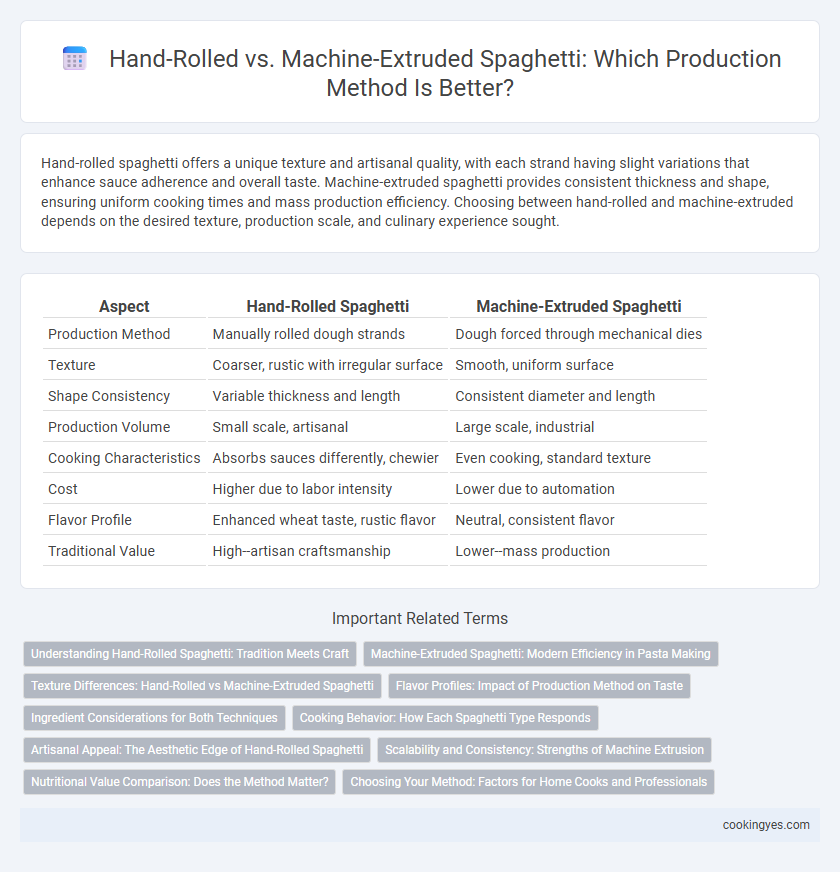Hand-rolled spaghetti offers a unique texture and artisanal quality, with each strand having slight variations that enhance sauce adherence and overall taste. Machine-extruded spaghetti provides consistent thickness and shape, ensuring uniform cooking times and mass production efficiency. Choosing between hand-rolled and machine-extruded depends on the desired texture, production scale, and culinary experience sought.
Table of Comparison
| Aspect | Hand-Rolled Spaghetti | Machine-Extruded Spaghetti |
|---|---|---|
| Production Method | Manually rolled dough strands | Dough forced through mechanical dies |
| Texture | Coarser, rustic with irregular surface | Smooth, uniform surface |
| Shape Consistency | Variable thickness and length | Consistent diameter and length |
| Production Volume | Small scale, artisanal | Large scale, industrial |
| Cooking Characteristics | Absorbs sauces differently, chewier | Even cooking, standard texture |
| Cost | Higher due to labor intensity | Lower due to automation |
| Flavor Profile | Enhanced wheat taste, rustic flavor | Neutral, consistent flavor |
| Traditional Value | High--artisan craftsmanship | Lower--mass production |
Understanding Hand-Rolled Spaghetti: Tradition Meets Craft
Hand-rolled spaghetti showcases artisanal craftsmanship through a meticulous process that allows for unique texture and enhanced flavor absorption. Unlike machine-extruded pasta, which uses uniform dies for precise shapes, hand-rolling creates subtle variations that impact cooking consistency and mouthfeel. This traditional method highlights the heritage and skilled labor behind authentic Italian spaghetti, appealing to consumers valuing artisanal quality.
Machine-Extruded Spaghetti: Modern Efficiency in Pasta Making
Machine-extruded spaghetti production utilizes advanced technology to ensure consistent thickness and uniform texture, significantly increasing output compared to hand-rolled methods. Extrusion machines force dough through precisely engineered dies, creating spaghetti with optimized surface texture that enhances sauce adhesion and cooking performance. This modern efficiency reduces labor costs and production time while maintaining high-quality pasta suitable for commercial distribution.
Texture Differences: Hand-Rolled vs Machine-Extruded Spaghetti
Hand-rolled spaghetti exhibits a rougher, more irregular surface texture, allowing sauces to cling better and enhancing flavor absorption. Machine-extruded spaghetti typically has a smoother, consistent texture due to the uniform shaping process, which results in a more even cooking time and firmer bite. The choice between hand-rolled and machine-extruded methods significantly impacts the tactile and taste experience of the final pasta dish.
Flavor Profiles: Impact of Production Method on Taste
Hand-rolled spaghetti exhibits a distinct texture that enhances sauce adherence, resulting in a richer and more artisanal flavor profile compared to machine-extruded pasta. The slow drying process of hand-rolled spaghetti preserves the wheat's natural aromas and yields a tender bite, intensifying taste complexity. Machine-extruded spaghetti, produced under high pressure, often has a uniform texture and a neutral flavor, making it ideal for consistent mass production but less nuanced in taste.
Ingredient Considerations for Both Techniques
Hand-rolled spaghetti allows for precise control over ingredient quality, often using artisanal flour blends that enhance texture and flavor. Machine-extruded spaghetti requires dough with consistent moisture and gluten content to ensure uniform extrusion and maintain structural integrity during drying. Both techniques benefit from high-protein durum wheat to achieve the desired al dente bite and minimize cooking loss.
Cooking Behavior: How Each Spaghetti Type Responds
Hand-rolled spaghetti exhibits a slightly rougher surface texture that allows sauces to cling better and tends to cook more evenly due to its porous nature, while machine-extruded pasta often has a denser, smoother texture that can result in a firmer bite and faster cooking times. The organic irregularities in hand-rolled spaghetti create variable water absorption rates, influencing tenderness and preventing overcooking. Machine-extruded spaghetti maintains consistent thickness, promoting uniform cooking but sometimes sacrificing the nuanced texture favored in artisanal pasta.
Artisanal Appeal: The Aesthetic Edge of Hand-Rolled Spaghetti
Hand-rolled spaghetti boasts a unique artisanal appeal characterized by its uneven, rustic texture that enhances sauce adhesion and elevates the overall dining experience. The handcrafted process imparts subtle variations in thickness and shape, distinguishing it from the uniformity of machine-extruded pasta. This aesthetic edge appeals to gourmet chefs and food enthusiasts seeking authenticity and tradition in Italian cuisine.
Scalability and Consistency: Strengths of Machine Extrusion
Machine-extruded spaghetti offers superior scalability by enabling high-volume production with consistent diameter and texture, crucial for meeting commercial demands. Automated extrusion processes ensure uniformity in strand thickness and cooking performance, minimizing variability inherent in hand-rolled methods. This consistency enhances product reliability and shelf life, benefiting large-scale pasta manufacturers and retailers.
Nutritional Value Comparison: Does the Method Matter?
Hand-rolled spaghetti retains more of the wheat's natural nutrients due to slower drying processes and less heat exposure, preserving higher protein and fiber content compared to machine-extruded pasta. Machine-extruded spaghetti, while more consistent in shape and texture, often undergoes high-temperature drying that can degrade some heat-sensitive vitamins like B-complex and antioxidants. Despite these differences, both methods provide comparable carbohydrate levels, making nutritional variation subtle but relevant for those seeking minimally processed pasta options.
Choosing Your Method: Factors for Home Cooks and Professionals
Hand-rolled spaghetti offers artisanal texture and unique irregularities prized by chefs, enhancing sauce adherence and flavor. Machine-extruded spaghetti ensures uniform thickness and consistent cooking times, ideal for large-scale production and efficiency. Home cooks should consider effort and time, while professionals prioritize consistency and scalability in method selection.
Hand-rolled vs machine-extruded for spaghetti production Infographic

 cookingyes.com
cookingyes.com